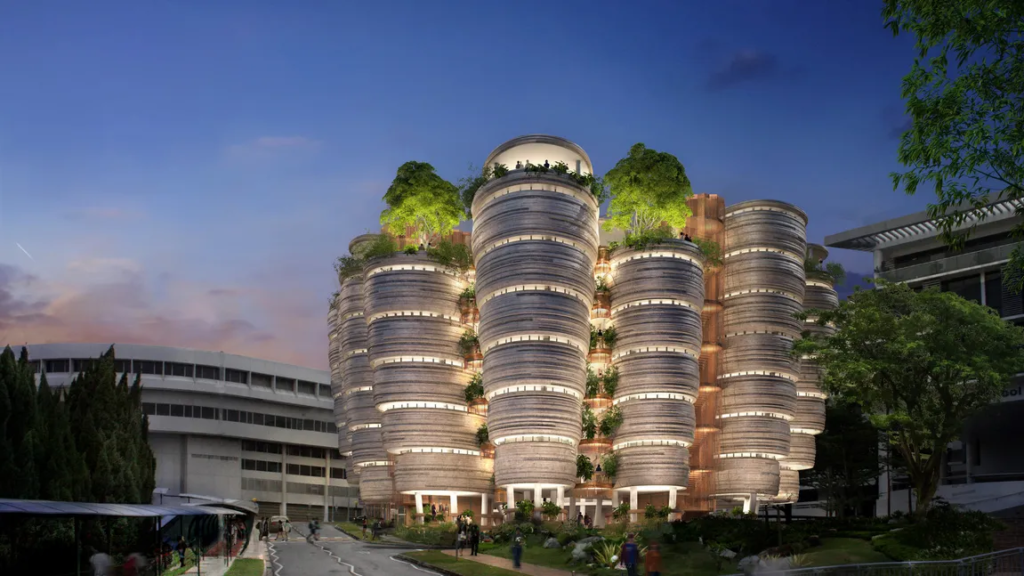Eco-Conscious Architecture in the Gulf: Merging Tradition with Innovation
The Gulf Cooperation Council (GCC) countries—Saudi Arabia, the United Arab Emirates (UAE), Qatar, Bahrain, Kuwait, and Oman—are leading the way in integrating sustainable design principles into their architectural landscapes. This movement combines traditional techniques with modern innovations to reduce environmental impact and promote sustainability in the region.

Traditional Techniques: A Foundation for Sustainable Design
Historically, Gulf architecture has been shaped by the harsh desert climate, leading to the development of building techniques that naturally mitigate heat and conserve resources. Elements such as wind towers (barajeel), thick adobe walls, and courtyards have been utilized to enhance ventilation, provide shade, and reduce the need for artificial cooling. These traditional methods not only reflect the region’s cultural heritage but also offer practical solutions for sustainable living.
Modern Innovations: Advancements in Sustainable Architecture
In recent years, GCC countries have embraced modern technologies to further their sustainability goals. Innovations such as solar panels, energy-efficient building materials, and smart building systems are being incorporated into new developments. For instance, the Mohammed bin Rashid Al Maktoum Solar Park in Dubai is one of the largest solar installations in the world, aiming to provide 75% of Dubai’s energy needs from clean sources by 2050 . Future developments are expected to further integrate traditional techniques with modern innovations, creating architectural solutions that are both environmentally responsible and culturally resonant.

Case Studies: Exemplars of Eco-Conscious Architecture
- Masdar City, Abu Dhabi: Designed as a zero-carbon city, Masdar City incorporates narrow streets, shaded walkways, and wind towers to naturally cool buildings. The city also utilizes renewable energy sources and sustainable building materials to minimize its environmental footprint .
- Al Bahr Towers, Abu Dhabi: These twin towers feature an innovative façade inspired by traditional mashrabiya screens. The dynamic shading system reduces solar heat gain by 50%, enhancing energy efficiency and occupant comfort .
- Msheireb Downtown Doha, Qatar: This redevelopment project aims to preserve Doha’s heritage while introducing sustainable urban planning. Buildings are designed to capture cool breezes, and materials are selected for their energy efficiency, contributing to a reduced carbon footprint .
Government Initiatives: Supporting Sustainable Architecture
Governments across the GCC are implementing policies and initiatives to promote sustainable architecture. The Estidama program in Abu Dhabi, for example, establishes guidelines for sustainable building practices, including the Pearl Rating System, which evaluates buildings based on their environmental performance . Similarly, the Dubai Clean Energy Strategy aims to reduce the city’s reliance on fossil fuels and increase the use of renewable energy sources .
Challenges and Future Directions
Despite significant progress, challenges remain in the widespread adoption of sustainable architecture in the Gulf. High construction costs, limited availability of sustainable materials, and the need for specialized skills can hinder implementation. However, as awareness grows and technologies advance, the region is moving towards more sustainable building practices. Future developments are expected to further integrate traditional techniques with modern innovations, creating architectural solutions that are both environmentally responsible and culturally resonant.

Conclusion
The integration of traditional techniques with modern innovations in eco-conscious architecture is transforming the Gulf’s urban landscapes. By drawing on its rich cultural heritage and embracing sustainable practices, the region is setting a global example for environmentally responsible development. As GCC countries continue to invest in sustainable architecture, they are not only preserving their traditions but also ensuring a greener, more sustainable future for generations to come. The Gulf Cooperation Council (GCC) nations are at the forefront of a transformative movement in architecture, where sustainability is not merely an aspiration but a tangible reality. By harmonizing traditional building techniques with contemporary innovations, these countries are crafting urban environments that are both environmentally responsible and culturally resonant.
Traditional methods, honed over centuries, offer invaluable insights into passive cooling, resource conservation, and climate-responsive design. These age-old practices, such as wind towers and thick adobe walls, are being reimagined in modern contexts, proving that heritage and innovation can coexist harmoniously.
Simultaneously, the integration of cutting-edge technologies—like smart grids, renewable energy systems, and sustainable materials—ensures that these developments are not only energy-efficient but also resilient in the face of future challenges.
WATCH MORE HERE: https://www.youtube.com/watch?v=qI3jTSFrEYg
READ MORE HERE: https://gulfmagazine.co/uaes-net-zero-by-2050-initiative-transforming-th/



